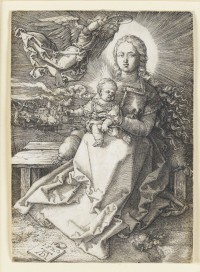 An 500-year-old engraving by Albrecht Dürer lost since World War II turned up in flea market in France. A retired archaeologist and art collector found copperplate engraving entitled Mary Crowned by an Angel at a stall of assorted tchotchkes in Sarrebourg in northeastern France close to the German border. Priced to move at just a few euros, the engraving had been acquired by the stall owner at a home clearance sale. Mary Crowned by an Angel
An 500-year-old engraving by Albrecht Dürer lost since World War II turned up in flea market in France. A retired archaeologist and art collector found copperplate engraving entitled Mary Crowned by an Angel at a stall of assorted tchotchkes in Sarrebourg in northeastern France close to the German border. Priced to move at just a few euros, the engraving had been acquired by the stall owner at a home clearance sale. Mary Crowned by an Angel
The buyer recognized it as a Dürer engraving and quickly bought it. When he examined it more closely, he saw a stamp on the back from the Staatsgalerie Stuttgart. Being a responsible, law-abiding type, he looked it up in the database of the German Lost Art Foundation which registers cultural items that were illegally seized usually by Nazis but also by other looters from private owners and institutions. The entry in the database confirmed that it was stolen and the new owner decided to return it to the museum. He and his wife went to the museum in person, long-lost Dürer engraving in hand, and gave it back.
“We are very grateful that, after more than 70 years, the work came to the hands of an art lover who did not keep his valuable find for themselves, but returned it to the public instead,” the museum’s director Christiane Lange said on Thursday.
How it got from Stuttgart 130 miles west to Sarrebourg is a mystery. It was likely stolen from storage at the end of the war in 1945 and crossed the border for a surreptitious sale. We know that at some point after the war it belonged to a former deputy mayor of Sarrebourg. None of the post-war owners can claim good faith since the stamp on the back of the engraving makes it clear that its legitimate owner was a museum.
At least the illegitimate owners treated it right, keeping it wrapped in paper and preserving it for 70 years. The engraving is in excellent condition, complete with the original matting. It depicts Mary holding a chubby baby Jesus (who looks, it must be said, distinctly over it all) while being crowned by an angel. It’s part of series of 15 engravings of Mary and the Christ Child Dürer printed at different times over the years.
The museum has not put the prodigal Mary on display yet. Officials are contemplating the best setting for their returned treasure. Perhaps a special Dürer exhibition is in order since the Staatsgalerie Stuttgart has an extensive collection of 250 prints by Dürer.
Real ‘flea markets’ in France and Belgium, i.e. not the ones for ‘professional art dealers’, where the stuff has been analyzed with immense scrutiny for at least 500 times, do often consist of private home disbandments. Thus, if he was in his 20ies during the war, our expert thief simply might have passed away.
Note that Herr Dürer must have made this engraving before July 8th in 1520, when he left for a business trip to Brussels, and he must have taken whole sets of prints (or copper plates ?) with him. From Antwerp, for example, he reports in September 1520:
… did the portrait of a noble lady at Tomasin’s house. I have given to Nicolas a ‘Jerome in the Cell’, and two new ‘Marys’. On Monday after St. Michael’s Day, 1520, I gave to Tommaso of Bologna a whole set of prints to send for me to Rome to another painter, who will send me Raphael’s work in return. …
“During WWII Germany again annexed Moselle. The US Army liberated and returned it to France in 1945. The French discouraged the Germanic heritage and therefore local German Lorraine Franconian dialects ceased to be used in the public realm.”
However, here a poem in Lorraine Franconian, as spoken around Sarrebourg:
Iwwer Berje konn mer krawwle
Durch Fliss konn mer schwimme
Maure konn mer abreisse
Sprooche konn mer lerne
Awwer die Bretter vor de Kepp !
… and a –remarkably– similar one in Eastern Franconian, also similar to the Eastern Franconian spoken by Dürer back then in Nuremberg:
Babiäkörb oozindn weils su schäi raung doud
Glodeckl oomondiän daß kannä mäiä scheißn koo
Delefonheislä hiimachen weil ann suwisu kannä oorufd
Obbä in dä errberrd di goschn ned aufbringä
:hattip:
Unfortunately all armies, going right back to the Trojan war, include looters. In fact, ancient armies “lived off the land” which made looting at least food, mandatory. Some armies even officially appoint looters to capture art and bring it home. The latter included Napoleonic, Russian and WW2 German forces. Even at this late date, the Russians still hold Schliemann items seized from the Museuminsel in Berlin in 1945.
And unfortunately all too many private individuals also take advantage of unrest, not just all out war. News coverage of natural disasters in our US often show looters make off with appliances, food, and anything else they can grab. So I respect the honesty of the buyer of the Duerer print.